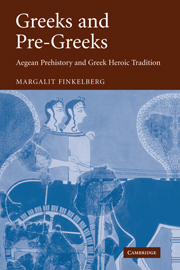Book contents
- Frontmatter
- Contents
- List of maps
- List of figures
- Preface
- List of abbreviations
- Chapter 1 Introduction
- Chapter 2 The heterogeneity of Greek genealogy
- Chapter 3 The pre-Hellenic substratum reconsidered
- Chapter 4 Kingship in Bronze Age Greece and Western Asia
- Chapter 5 Marriage and identity
- Chapter 6 The spread of the Greek language
- Chapter 7 The end of the Bronze Age
- Chapter 8 Continuities and discontinuities
- Appendix: The Testament of Hattusili
- List of references
- Index of passages cited
- General index
Chapter 3 - The pre-Hellenic substratum reconsidered
Published online by Cambridge University Press: 22 September 2009
- Frontmatter
- Contents
- List of maps
- List of figures
- Preface
- List of abbreviations
- Chapter 1 Introduction
- Chapter 2 The heterogeneity of Greek genealogy
- Chapter 3 The pre-Hellenic substratum reconsidered
- Chapter 4 Kingship in Bronze Age Greece and Western Asia
- Chapter 5 Marriage and identity
- Chapter 6 The spread of the Greek language
- Chapter 7 The end of the Bronze Age
- Chapter 8 Continuities and discontinuities
- Appendix: The Testament of Hattusili
- List of references
- Index of passages cited
- General index
Summary
ANATOLIAN LANGUAGES AND THE AEGEAN SUBSTRATUM
Who were the Inachids, the Pelopids and the other population groups with whom the Greek-speaking tribes intermingled in the course of the second millennium bc? Until recently, the answer would have been that these were speakers of the unknown language or a group of languages to which the suffixes -nth- and -ss- belonged. However, today we seem to be in a position to give a more qualified answer to this question.
It has long been recognised that the suffixes -nth- and -ss-, the identification of which gave rise to the hypothesis of the pre-Hellenic Aegean substratum, are actually identical to the suffixes -nd- and -ss- of the languages of Asia Minor (see Maps 1 and 2). At the end of the nineteenth century, when Kretschmer drew scholarly attention to the suffixes in question, the languages of Asia Minor attested in the Classical period, such as Lycian, Lydian and Carian, were generally considered not to belong to the Indo-European family of languages. Accordingly, Kretschmer's conclusion was that the linguistic substratum he discovered should be identified as non-Indo-European. No one could have imagined that it would soon be shown that a language belonging to the Indo-European family was in use in Anatolia in the second millennium bc. Ironically, the new picture of Indo-European began to emerge precisely in the years that gave rise to the orthodoxy of the non-Indo-European pre-Hellenic substratum.
- Type
- Chapter
- Information
- Greeks and Pre-GreeksAegean Prehistory and Greek Heroic Tradition, pp. 42 - 64Publisher: Cambridge University PressPrint publication year: 2006



